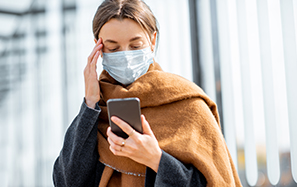Why wearing face masks is the only logical conclusion… for now. Today two sources provided new information about how we should handle the coming days’/weeks’ “unfavorable” weather in order to faster stop the virus’ spread. This is an article from the LA Times about the gathering of a gospel choir on March 10th, 100 km […]
Lees volledig artikel: Why wearing face masks is the only logical conclusion… for now.
Why wearing face masks is the only logical conclusion… for now.
Today two sources provided new information about how we should handle the coming days’/weeks’ “unfavorable” weather in order to faster stop the virus’ spread.
This is an article from the LA Times about the gathering of a gospel choir on March 10th, 100 km north of Seattle (where the virus was already present in February). It gives detailed information on how many of the attendees fell ill and how many of those have passed away by now.
The most important facts from the article are:
- 60 people rehearsed for 2,5 hours in a church, in an assigned area the size of a volleyball field. The majority were older people.
- They followed the rule of 1,5 meter distance between individuals and made sure not to touch one another.
- None on them felt any symptoms of illness or was coughing at the time. (But they did sing of course.)
- By now, 45 out of 60 have been diagnosed with COVID-19, 3 of those 45 are dead and 2 are still in hospital. The average age of the infected was 67, but those who died were (significantly) older than that.
- Already after 3 to 4 days some of the singers showed symptoms of the disease.
So, the first conclusion is that many who encounter the virus can fall ill. Perhaps the elderly more so than the young. Either way, (based on other sources) the elderly have a much higher chance to die from the virus.
Airborne
The article gives evidence for the virus’ ability to stay airborne longer than expected thus far. (And hence can be transferred in more ways than just coughing or sneezing, which has previously been claimed by the WHO).
It’s interesting to see that many worldwide religious gatherings (even in South-Korea) have been points of big outbreaks.
In the Netherlands we see the pattern of smaller communities experiencing big outbreaks through elderly people regularly attending church in these communities. (The decision to still allow religious gatherings in the Netherlands with a maximum of 30 attendants doesn’t seem that smart anymore)
In short: these kind of buildings can cause this virus to spread quickly, because churches are usually not as well heated as normal buildings, nor do (or will) they raise the humidity level with special machines. Hence, the specific humidity in which this choir has been singing must have been almost the same as it was outdoors, which I have calculated to be at around 5,3 g/kg, based on the official weather information.
Magic number
Now that does not prove my initially mentioned “magic number” of 6 g/kg to be true in itself. However, it does not reject it either. Things become clearer when we review the patterns I noticed for Italy regarding the relation between number of infected and deceased and the humidity. In the North of Italy, the outbreak is 20 times bigger than in the South.
My thesis is the following: when the humidity is higher, the chance of the virus spreading widely among those present is (significantly) lower. The spread of the virus in Italy’s southern provinces being much slower than in the northern ones supports this.
Churchliness and faith seem to be evenly spread in Italy. (And when I look at other countries, such as the Philippines, which has many believers and a high humidity too, I see there are also relatively few infections and deaths.)
Combining these findings with an important graphic leads to the following points of action:
- Let the authorities and/or scientists resolutely resort to finding out how humidity relates to the virus’ spread. Is that limit of 6 g/kg correct, or is it somewhat lower or higher? And does the spread decrease abruptly (which is my guess) or smoothly?
- As a precautionary measure I would resort to raising the humidity in spaces where many unrelated people gather as soon as possible plus natural ventilation. If the government does not do this then we should do it ourselves. At room temperature (70 degrees Fahrenheit) that would mean a relative humidity of around 45%. We have seen strong evidence for this to be an effective measure already. (Especially in shops, hospitals, offices that are still open and in other buildings with many people). At home, raising humidity is only relevant when you are visited a lot.
- Last but not least: In the Northern part of the US, there will still be days when the specific humidity will remain below 6g/kg. (Here is the calculator to calculate that value based on temperature and relative humidity). So what can we do on “bad” weather days?
Right after reading this article I received two new sources of information.
First the following image. Perhaps jumping to conclusions, but it cannot go unnoticed that Japan and South-Korea have good control over the outbreak. And China too, has been able to control the virus from spreading after their outbreak in January/mid-February. Scientific journalist Roxanne Khamsi pointed this out in one of her interesting tweets, mentioning that the virus stays airborne much longer than we expected. And that masks can greatly reduce the emission of the virus.

The Cuban government has decided people can only leave their house when wearing some sort of nose and mouth protection. Without it, people are even banned from public transport. Professional masks are not required because of low availability, but some sort of protection will at least prevent or slow down the possible transferal of the virus.

(Keep in mind that because of the higher humidity, the Cuban people are at a significantly lower risk of attracting the airborne virus than the Dutch, but still it’s not an unnecessary measure for the time being.)
Humidity
Based on what I know now I came to the opinion, that the following points form the best policy to fight the virus in countries and states with a relatively low specific humidity:
- Prohibit religious gatherings of 30 people or more. No exceptions.
- Highly prioritize investigating the 6 g/kg mark and if it can be shown or adjusted.
- Until this exact boundary is known, raise the humidity in places where people gather that do not know each other or barely interact to levels equal to 45% at room temperature (70 degrees Fahrenhei).
- For as long as we don’t know enough about that mark and when we face “unfavorable” weather, we should apply Cuban measures: going outside requires covering your face by either a mask, a bandana or shawl.
- As soon as we know which weather minimizes the virus’ spread through the air, or when its threat is over can we gradually lessen our measures. Say the virus indeed does not float in the air at 6,2 g/kg, then we can soften the current (or by then even stronger) policy.
These are special times, which require special solutions. (As well as proper research).
You have just read: Why wearing face masks is the only logical conclusion… for now.







